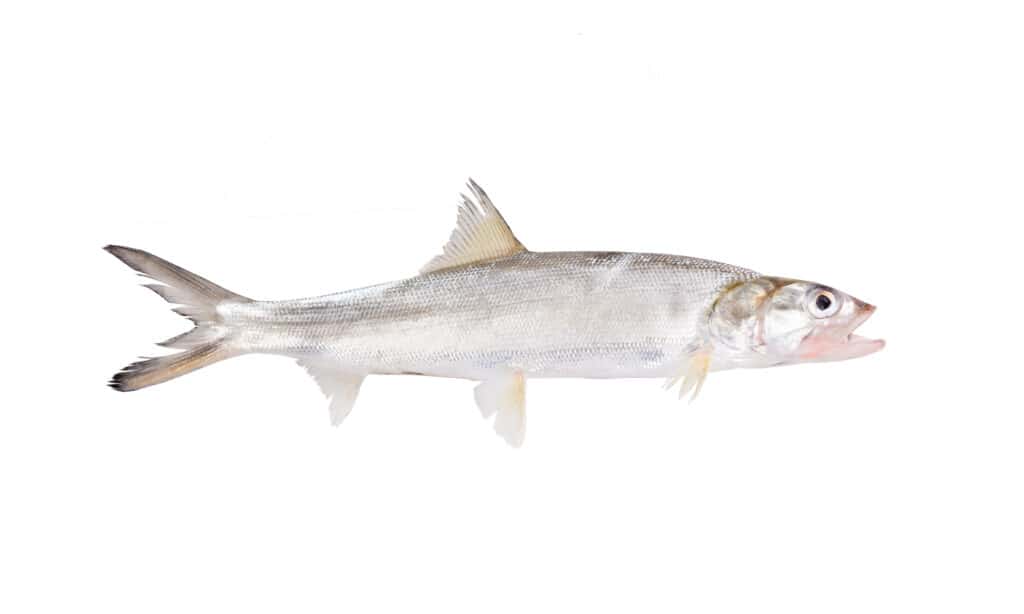Ladyfish
E. saurus
Ladyfish are aggressive fighter when hooked, making them a favorite of anglers.
Advertisement
Ladyfish Scientific Classification
- Kingdom
- Animalia
- Phylum
- Chordata
- Class
- Actinopterygii
- Order
- Elopiformes
- Family
- Elopidae
- Genus
- Elops
- Scientific Name
- E. saurus
Read our Complete Guide to Classification of Animals.
Ladyfish Conservation Status
Ladyfish Facts
- Prey
- Crabs, Smaller Fish, Squid, Insects
- Name Of Young
- Fry
- Group Behavior
- Solitary
- Group
- School
- Fun Fact
- Ladyfish are aggressive fighter when hooked, making them a favorite of anglers.
- Other Name(s)
- Ten-pounder, Lady Fish
- Optimum pH Level
- Just about anything
- Average Spawn Size
- unknown
- Habitat
- Coastal waters
- Predators
- Larger Fish, Some Birds
- Diet
- Carnivore
- Lifestyle
- School
- Favorite Food
- crustaceans
- Location
- Western North Atlantic, Gulf of Mexico
- Nesting Location
- Off-shore
View all of the Ladyfish images!
Despite not being very yummy, Ladyfish are regularly caught by anglers.
The Ladyfish is a long, slender saltwater fish found in the western North Atlantic Ocean and the Gulf of Mexico. They are also sometimes known as skipjacks or tenpounders.
While they are not the best fish for eating, they are a popular sport fish for anglers since they put up an aggressive fight once they are hooked. They are known as the “poor man’s tarpon” since they are easy to catch and fight, similar to tarpon.
4 Ladyfish Facts
- Ladyfish are thermophilic; they cannot tolerate low temperatures for very long. Sometimes when the weather is unusually cold in Florida, dead fish can be found in numbers.
- Many consider Ladyfish to be “trash fish” since their meat is dry and bony and has a strong “fishy” taste. This makes them bad fish to eat but excellent fish to cut up and use as bait.
- For sport fishing, Ladyfish are popular because they are easy to find and put up an aggressive fight. They repeatedly jump into the air and spend much time out of the water as they are hooked. This exciting action has earned them the nickname “poor man’s tarpon.”
- Ladyfish go through an interesting growth process from larvae to juvenile. They progress from long, transparent, ribbon-like larvae that absorb nutrients from the water to small carnivorous fish.
Ladyfish Classification and Scientific name
The scientific name for Ladyfish is Elops saurus. They are also sometimes called “tenpounder” or “skipjack.” Ladyfish are in the order Elopiformes and the family Elopidae. This family contains 9 species that are all sometimes grouped together and called Ladyfish.
Most of the species in this family are similar but are native to different regions. For example, the Elops affinis is known as the “Pacific Ladyfish” because it is similar to the Elops saurus, but is found in the Pacific along the southwestern United States coast. Elops comes from the Greek word ellops, meaning “a kind of serpent.”
Ladyfish Appearance
Ladyfish have a long, slender, rounded, pike-like body covered with small, fine silver scales. Their tail is extremely forked, and their large mouth has small, sharp teeth. In general, they are silver in color, with their upper body having a bluish or greenish hue.
Ladyfish have smaller scales than most other fish its size, with more than 100 in a lateral line. They can grow up to 3 ft long and weigh up to 22 pounds. However, this is unusual. Most of them, in general, are between 2 to 3 pounds.

The long, sleek Ladyfish is an excellent game fish, much favored by anglers.
©IrinaK/Shutterstock.com
Ladyfish Distribution, Population, and Habitat
Ladyfish are most common in the coastal brackish/saltwater lagoons, estuaries, bays, and along shorelines. This makes areas such as the outer banks of North Carolina and the inland waterways of Southwest Florida ideal areas to find these fish.
They like brackish areas where freshwater rivers and streams meet the ocean, especially areas with mangroves. They can also be found several miles offshore at depths up to 160 feet.
According to the IUCN, the Ladyfish’s conservation status is of Least Concern and is considered plentiful. Because they are not good fish to eat, they are not commercially harvested.
Ladyfish Predators and Prey
The Ladyfish’s diet varies depending on age. When they first hatch, they simply absorb nutrients from the water. Then, they will gradually change to zooplankton and insects. As they grow larger, they switch to crustaceans such as shrimp. Adult Ladyfish are carnivores and mainly feed on small body fish and crustaceans.
What Eats Ladyfish?
The Ladyfish’s main predators are larger fish. They are also popular bait fish for anglers. Predators of smaller Ladyfish include other fish, along with inland waterfowl, alligators, turtles, and other large birds.
What Do Ladyfish eat?
Young Ladyfish eat zooplankton and insects, with adult fish concentrating on other fish and crustaceans.
Ladyfish Reproduction and Lifespan
Ladyfish spawn offshore throughout the year, depending on the geography. In Florida, spawning is thought to occur during the fall months. Since they spawn offshore, little is known about the spawning process, other than the females laying eggs and the males fertilizing them.
After hatching, the young larvae have a long, ribbon-like, transparent body with large fang-like teeth and small fins. They lack gills and red blood cells, and nutrients are absorbed through the skin from the water.
During the next growth stage, the larvae drastically decrease in length and lose the ribbon-like shape. In the next stage, the larvae transition to the juvenile stage, resembling minnows, decreasing in length and growing fins. It is unknown when these fish mature, but they can live for at least 6 years.
Ladyfish In Fishing And Cooking
Ladyfish are a popular sport fish since they are easy to catch and put up an aggressive fight compared to their size. When hooked, they will make quick runs and leap wildly out of the water into the air. They have been nicknamed the “poor man’s tarpon” due to this behavior.
These fish can be caught with a fly rod and spin casting, with bait including shrimp, cut bait, spoons, small jigs, and plugs. They are aggressive feeders, so any appropriately sized bait will typically work. Ladyfish feed in schools, so to find them look for diving birds and splashing bait fish on the surface. They will often be nearby, feeding on the smaller fish.
The meat of this fish is dry and bony, so it is not very good to eat. However, they are excellent bait for other larger fish. Anglers will often catch Ladyfish, cut them up, and use them as bait for Tarpon or other larger fish.
Their flesh produces a strong fishy aroma that travels in the water well to attract other fish. Local regulations should be checked, but typically since they are so abundant, there is no limit on the number that can be caught or size limits.
Similar Animals
View all 98 animals that start with LLadyfish FAQs (Frequently Asked Questions)
Where are Lady Fish Found?
Lady Fish can be found along the Atlantic coast from Nova Scotia to the Gulf of Mexico. They are most abundant in the brackish coastal waterways in North Carolina and southwestern Florida.
Thank you for reading! Have some feedback for us? Contact the AZ Animals editorial team.
Sources
- Wikipedia / Accessed September 25, 2022
- Wikipedia / Accessed September 25, 2022
- Take Me Fishing / Accessed September 25, 2022
- Guidesly / Accessed September 25, 2022
- Florida Museum / Accessed September 25, 2022


















